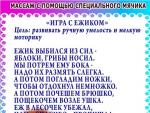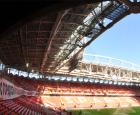Exercises with a ball for the stomach. The best exercises on a fitball to achieve an ideal figure. Examples of ready-made training programs with fitball
The benefits of this type of aerobics, its effectiveness and to whom it is recommended are described. Below we will describe the basic exercises that you can perform on a fitball (rubber fitness ball) without even leaving your home.
I work through all the exercises on a rubber ball well. t all muscle groups, especially the abs, legs, buttocks, back and chest.
Fitball exercises:
♦ Bridge
Lie with your back on the ball in the area of the shoulder blades, arms along the body or laid back and lying on the ball, butt in weight, torso straight, legs slightly bent at the knees, spaced shoulder-width apart and resting well on the feet. Lower your hips down so that the floor is 20-30 cm, but your butt does not touch the floor, then, straining your muscles, lift your hips up so that your torso forms a straight line from your chest to your knees. Hold at the top for 3 seconds, additionally tensing your abs and buttocks, and lower down without pausing to go up again.
♦ Torso turns
 now
now
Take the position of a straight torso as in a bridge, only stretch your arms up in front of you, and clasp your palms. Tightening your abs, rotate your torso alternately to the left and right. Only the upper part of the body moves, the lower remains motionless in one position.
 ♦ Hold on elbows
♦ Hold on elbows
Rest your forearms and elbows on the fitball, legs shoulder-width apart, feet on your toes resting on the surface, the body must be straight . Easily pushing off on your toes, begin circular movements on the ball, choosing such a radius of movement that your elbows stay on the ball and do not fall to the floor.
 ♦ Staying on your feet
♦ Staying on your feet
Rest your elbows on the floor, the elbows are under the shoulders forming a right angle, the torso forms a straight line, the legs in the easy version rest on the shin, in the complex version on the toes. Tighten the muscles of your buttocks and abs, do not allow your lower back to sag under the weight. When pushing off, make light movements left and right so that your legs roll on the ball, making sure that they do not slip off the fitball.
 ♦ Walking on your hands
♦ Walking on your hands
Place the ball under your hips, place your palms on the floor, and straighten your legs so that they are parallel to the floor. Keeping your legs always straight, walk forward on your hands until the ball is on your shin and back, returning it under your hips.
 ♦ Twisting:
♦ Twisting:
You need to lie on the ball in the lower back area, hang your hips slightly down, place your fingers on the back of your head, and use your abdominal muscles to twist your abs. The amplitude of the movement is small, the importance is that not for a second do not relax your abdominal muscles and do not help press your head with your hands , concentrate all your efforts on the abdominal muscles and keep it in constant tension;
Also perform side crunches, to do this, place the ball on the side of your lower back, it is better to rest your feet against the base of the wall, one hand rests on the ball, and the other behind the back of your head. Keep your body straight as a string and twist your torso to the side.
 ♦ Leg bends to the sides with the ball
♦ Leg bends to the sides with the ball
Lying on your back, spread your arms to the sides and place your palms on the floor for support. Holding the ball between your feet, lift it up, straining your abs and buttocks, and alternately bend your legs to the sides, keeping your shoulder blades and palms from the base of the floor.
♦ Passing the ball
 and from feet to hands
and from feet to hands
Lying on your back, take the ball between your feet and lift it up, while simultaneously raising your arms up, intercept the ball and lower your arms down behind your head while lowering your legs. Do the exercises back in the same manner.

♦ Push-ups on a fitball
Place your palms slightly on the sides of the ball, inhaling, lower down until your chest lightly touches the ball, and as you exhale, rise up while maintaining a straight line of your torso from the back of your head to your heels.
For variety, do reverse push-ups with your hands on the floor and your toes resting on the ball.
To complicate the exercise, do push-ups on two balls, so the stabilizer muscles are additionally involved in the work.
♦ Hyperextension
 on the ball
on the ball
Take a position parallel to the floor, lying on the ball in the abdominal area, legs straightened at the knees and resting on your toes, forming an even line, put your hands behind your head, but do not put pressure on the back of your head. Slowly lift your back up until you form a straight line from your heels to your head, then return to the starting position.
To complicate the exercise, at the beginning of the movement, your arms are crossed on your chest, and as you rise up, spread them to the side, so the upper back is included in the work.
All movements are slow, without jerking, clearly controlled, exhale with effort, inhale with relaxation (in other words, when lowering the body, inhale, when lifting, exhale).
Experiment, come up with other exercises, don’t be afraid to use your imagination, the main thing in the training process is a deep feeling of the muscles being trained, at the end of the exercise the muscle should be tired, hard and slightly swollen, this means that the load went exactly to the target.
What can you do with this bulky inflatable ball that takes up so much space at home?
In fact, a fitball (that’s what this ball is called) is an excellent tool for keeping your body toned. You perform the exercises in a shaky position, which also forces you to maintain your balance. And this is an additional load on the muscles.
By the way, exercises using balls are often performed by athletes during the rehabilitation period after injuries. This is due to the fact that the ball helps reduce the stress on the muscles and spine compared to conventional exercises.
Before we get to the training, let's decide on the size of the ball that you will be comfortable working with.
Most balls come in three sizes:
- 55 cm - for those who are 150–160 cm tall;
- 65 cm - for those who are 160–170 cm tall;
- 75 cm - for those who are 170–200 cm tall.
Based on this list, you can choose the appropriate one. Or there is another screening test that will help determine the ideal ball size for you. All you have to do is sit astride the ball. If your thighs and shins form a right angle, then this ball is the right size for you.
When performing the exercises that we will discuss below, determine the number of repetitions and approaches depending on your level of training. We recommend performing 3-5 sets of 10-20 repetitions of each exercise. Start with a small amount and then build up the load.
Ready? Go.
Lower body exercises
This group of exercises is designed to work the core muscles of the legs.
1. Squats with a ball over your head
This exercise is based on regular squats, the only difference is that you hold the ball above your head with outstretched arms.
2. Wall Squats
This exercise uses a ball to support your back. During the exercise, it should move from the lower back to shoulder level.
3. Squeezing the ball with your thighs
It may look funny, but the exercise works great for the muscles of the hips and lumbar region. Squeeze the ball to maintain balance. Hold this position for 30–45 seconds.
For this exercise, it is better to use a smaller ball than a regular ball.

Lie on the floor, extend your arms perpendicular to your body. Place the lower part of your shin and heel on the ball. Using your abs and buttocks, lift your hips off the floor. You will find yourself in a precarious position, so use your outstretched arms to maintain balance.
Exhale and slowly bring your knees toward your hips so that your feet are on the surface of the ball. Hold this position for a second, then inhale and stretch your legs back out. Always keep your hips weighted to give maximum load to the muscles of the buttocks.
5. Squats while holding the ball in front of you
This exercise simultaneously works the muscles of the arms, abs and legs.
6. Lunges with a ball
When performing this exercise, make sure that the knee of the leg standing on the floor does not go beyond the level of the toe. To maintain balance, you can hold on to a support (for example, a chair).
7. Reverse hyperextension
Upper body exercises
This set of exercises works the muscles of the arms and shoulders.

These aren't just the push-ups you might be used to. This is a more complicated version of them because you have to keep your balance.
9. Plank
Unlike the usual plank, which is performed on the floor, this variation puts even more stress on the shoulders and arms. Hold the position for at least 30 seconds if you can.
10. Reverse ball crunches

Yes, and this effective exercise can be performed on a ball.
12. Triceps curl
13. Spire
Exercises for the torso
This set of exercises with a ball is aimed at loading the muscles of the torso.
14. Ab exercise
In the top position, hold until you count to five, and then slowly lower. The number of repetitions is 6–10 depending on your preparation. Pulling your knees towards your stomach
Starting position as for push-ups. Just instead of bending your elbows, tuck your knees under you and straighten your legs back.
18. Raising your knees while lying on the ball
While performing this exercise, you need to press your knees firmly against each other so that your legs do not move apart. To avoid pain, hold a towel between your knees.
19. Exercise for the oblique muscles of the torso
Sit directly on the ball. Hands behind your head. Bring your legs together and lower your feet to the floor. Then simultaneously move your legs to the right and turn your body to the left. Do 12–15 reps on each side.
20. Bend to the side with the ball
It is useful to finish your abdominal exercises with stretching. Place your feet shoulder-width apart, hold the ball above your head, and keep your back straight. Bend over and bring the ball to the outside of your left leg. Keep your back straight as you bend over. Raise the ball again and lower it to the right side.
More recently, fitball, originally created to improve the health of people with musculoskeletal disorders, has become firmly entrenched in the fitness industry. This unique gymnastic ball helps girls lose weight at the waist and give their butt a rounded shape without any extra effort. A fitball easily replaces all types of exercise equipment, so it is perfect for training both in the gym and at home. In this article, we will teach you how to choose the right fitball, and also provide a comprehensive program for all muscle groups using this miracle ball. Let's get started!
Fitball can be used in their training by both men and women. It is suitable for all ages and has no contraindications! This ball has undoubted benefits and has many advantages:
- due to its instability, it helps improve coordination of movements, which promotes correct posture;
- the muscles, while maintaining balance, are in constant tension, and this is combined with a set of exercises promotes rapid weight loss;
- gymnastics on a ball improves the condition of joints, helps with scoliosis, relieves pain in the spine;
- different muscle groups are involved, which can rarely be worked out during regular training in the gym;
- when training on a ball, the muscles of the lower extremities are not loaded, so fitness ball is excellent Suitable for older people, pregnant women () and overweight people;
- metabolism, activity of the cardiovascular and respiratory systems improves;
- fitball absolutely safe, it is protected from sudden rupture during training due to the built-in ABS anti-burst system;
- lifts your mood and improves your well-being.
Help in choosing the right fitball
When choosing a gymnastic ball, there are several main factors to consider:
- Size. The diameter of the ball ranges from 45-95 cm. When choosing a ball, a simple formula is used: a person’s height minus one hundred. The resulting number is your ball diameter. Please note that the larger the diameter of the ball, the more stable it is. Check if the ball is right for you. Sit on the ball, bend your legs to form a 90-degree angle, and place your feet flat on the floor. Look at the photo:
- Material. Pay special attention to the country of origin. Countries such as Germany and Italy have performed well. The ball should be elastic and durable, the connecting seams should not be felt during exercise.
- Fitball surface. Balls with a smooth surface are a universal exercise machine and are suitable for everyone. It is easier to maintain balance on a ball with horns, so it is great for both children and adults who are just starting to train. Fitballs with spikes are used for exercises with an additional massage effect or for restorative gymnastics.
Important! You can independently regulate the degree of load when performing exercises on a fitball! A heavily inflated ball is less stable, so more effort is applied and the calorie burning process accelerates!
Correct training technique
Before starting exercise on the fitball, do a short warm-up. This way, you will minimize the risk of muscle injury.
Perform 1-3 sets of 15-30 repetitions. Increase repetitions gradually as you feel better.
Perform the exercises slowly, focusing on the muscle group being worked. Control your breathing.
Take a short rest of up to 1 minute between sets.
After completing the program, do some stretching.
For the desired effect, perform the exercises at least 2 times a week.
Important point! If you are using a fitball for post-traumatic rehabilitation, consult your doctor when choosing a training complex.
Complex program (table) using fitball
Before starting any workout, you need to stretch your muscles as effectively as possible. Below is an incendiary video that can be used as a warm-up before training, and such morning exercises will charge you with a positive attitude for the whole day!
For beginners, it is necessary to train all muscle groups for the harmonious development of the body. And only after at least a year can you use individual muscle groups!
Below is a table with an approximate program of exercises with a fitball at home and in the gym, which involve different muscles.
| Muscle group | Exercises | Number of approaches*repetitions |
| Press | 3*10-15 | |
| 3*10-15 | ||
| Pectoral muscle, arms | 3*10-12 | |
| Push-ups, feet on fitball | 2*5-8 | |
| Reverse push-ups | 2*10-12 | |
| Back | Hyperextension on a fitball | 3*10-15 |
| Buttocks and thighs | Lifting the pelvis while lying on your back | 3*15-20 |
| 3*10-15 | ||
| 3*15-20 |
Lie on the ball with your back so that your lower back is on the ball and your shoulders and head are hanging freely. Legs bent at the knees, place your feet slightly wider than your shoulders. To avoid straining your neck muscles, cross your arms over your chest. This is your starting position. Lift your body up, your back should be slightly rounded for the most complete contraction of your abdominal muscles. Hold at the top for 2-3 seconds and slowly lower back to the starting position again. Repeat 3 sets of 10-15 times.

This exercise strengthens the rectus abdominis muscle. To engage the oblique abdominal muscles, use body rotations.
Lie on the ball with your stomach and roll so that your hands are on the floor and your knees remain on the ball. The body is elongated in a straight line, do not bend at the lower back. Transfer your body weight completely to your arms. Pull your knees toward your chest as you roll the ball. Return your legs to the starting position. Perform 3 sets of 10-15 repetitions. The exercise works well on the transverse abdominal muscles and uses the muscles of the arms, chest, and deltoid muscles.

Advice! To complicate the exercise, pull the ball with straight legs without bending your knees.
Hold dumbbells of appropriate weight in your hands and lie on the exercise ball with your back so that your upper back and head are on the ball. Bend your knees at an angle of 90 degrees, place your feet shoulder-width apart on the floor. The body forms a straight line. Take the dumbbells with a straight grip as shown in the photo or hold them parallel to each other to better work the entire pectoral muscle. Slowly lower your arms to shoulder level and return to the starting position. Repeat 3 sets of 10-12 times. This is an isolation exercise for the pectoral muscle.

To work the upper chest, lower your pelvis below your shoulders, with your upper torso and legs forming a 45-degree angle.
The exercise is a classic push-up using a fitball. Place your feet on the ball with your toes and your hands on the floor. The body is parallel to the floor, do not bend at the lower back. Slowly lower your body, bending your elbows. Hold the position and return to the starting position. Perform 2-3 sets of up to 5-8 reps. The arm muscles, pectoral and deltoid muscles work.

Advice! To make the exercise more challenging, lift one leg up and do push-ups.
Reverse push-ups
Turn your back to the ball and place your hands on it. Legs bent at the knees, place your feet at a distance slightly less than shoulder width. Slowly lower your pelvis down, bending your elbows to a right angle. Do not spread your elbows to the sides. Return to the starting position. Lower your pelvis straight down, your body should walk in a vertical plane. Perform 2-3 sets of 10-12 times. The exercise fully loads the triceps, while the pectoral and deltoid muscles are also involved.

Lie on the ball with your stomach so that the ball is in the pelvic area. Place your toes on the floor. Place your hands behind your head or cross your chest. Slowly lift your body, straightening your back at the lumbar region. Hold this position for 1-2 seconds and return to the starting position. Perform 3 sets of 10-15 times. The exercise works the muscles of the lower back, hamstrings and glutes.

Lifting the pelvis while lying on your back
Lie with your back on the floor, place your heels on a fitball, arms along your body. Slowly lift your pelvis so that your body forms a straight line. Hold the position for a few seconds and squeeze your buttocks as hard as possible. Slowly return to the starting position. Perform 3 sets of 15-20 repetitions. The exercise loads the gluteal muscles, thigh muscles, and abs.

Single leg lunge squats
Stand with your back to the ball, place one foot with your toe on the fitball. Place your hands on your belt or hold onto a support for additional balance. Keeping your body upright, bend your knee so that your knee does not extend beyond your big toe. After completing the squat, return to the starting position. Perform 3 sets of 10-15 repetitions on each leg. The exercise uses the muscles of the buttocks, quadriceps and hamstrings.

Leg bending with a fitball
Lie on your back with your feet on the ball as shown in the picture. Raise your pelvis slightly off the floor, supporting your body weight with your shoulder blades and legs. Bend your legs, bringing the ball as close to your hips as possible, and straighten your legs again. While performing the exercise, tighten the back of your thigh as much as possible. Repeat 3 sets of 15-20 times. The exercise loads the hamstrings, buttocks, and lower back.

Important! Change the exercises in the complex every month, so you don’t get tired of training and use different muscles. For strength training, use additional weights during exercise.
A wide variety of exercises using a gymnastic ball are collected in the following video tutorial:
The described set of exercises is excellent for aerobics at home and allows you to achieve good results with regular training in combination with a balanced diet.
After completing a set of exercises to quickly restore muscle fibers and give flexibility to your figure do some stretching. The video shows a three-minute stretch using a ball:
Fitball is a popular aid not only in losing weight and maintaining muscle tone, but also in strengthening and restoring physical health. If you are in a bad mood and stressed, just sit on the fitball and your good mood will return to you.
Have a great workout!
Girls and women who take care of themselves, regardless of age, pay great attention to their figure, doing everything possible to make it slim and attractive. For this purpose, they visit gyms and fitness centers, because physical exercise will allow them to correct their figure in problem areas. Particularly popular are exercises with a fitness ball, which can be performed even while at home, without special training.
This special device is often called a fitball or gymnastic ball. Regular exercise with a fitness ball has a positive effect on the body, namely:
- muscle tone increases;
- body flexibility develops;
- coordination improves;
- fat deposits are burned.
In order for exercises on the ball to be beneficial, it is important to choose the right indispensable device. For this purpose, it is better to visit sporting goods stores, where sellers must provide a table of the optimal ratio of the diameter of a gymnastic ball and the height of the athlete.
Rules for practicing on a gymnastic ball
A set of specially designed and selected exercises on a gymnastic ball for fitness will only be beneficial if you follow some important rules. First of all, you should adhere to these recommendations from experts:
- Classes should be held regularly, without long breaks. To achieve a positive result, it is enough for fitness training to take place 2-4 times a week.
- You cannot overexert your body, so you need to take a break between exercises. Depending on the level of physical fitness and endurance of the body, training can last 30-60 minutes.
- You can try several methods of fitness, because this sport is quite diverse, so each person will certainly find the most suitable exercises for himself.
- To make your workouts enjoyable every time, you need to diversify them by choosing new exercises with a fitness ball.
- As you know, only the correct technique for performing exercises with a gymnastic ball will benefit from the exercises, so you must first either visit a fitness center or watch a video.
Exercises for perfect abs
By performing a set of abdominal exercises, all muscles are worked out, thanks to which you can achieve your goal much faster than with other physical activities. Experts recommend performing the following abdominal exercises:
- Starting position: sit on a fitball, rest your feet on the floor, cross your arms over your chest. Move your feet forward so that your back is on the ball, your knees are under your ankles, and your head should be supported. Then slowly raise your upper body until you feel tension in your abdominal muscles and return to the starting position. Repeat 1-2 times at the beginning of training, eventually increasing the number of approaches to 10.
- Starting position: lie with your back on the floor, hold the ball with your ankles, keep your legs straight, and grab some support with your hands. Then bend your knees and smoothly pull them towards your chest, without releasing the ball. Hold for a couple of seconds and return to the starting position. Repeat the exercise up to 10 times.
- Starting position: lie on your back, legs straight, take a fitball in your hands and lift it above your head. In this position, slowly lift your head, shoulders and back off the floor and pull your hands with the ball towards your feet. Then smoothly lower your upper body to the floor, raising your straight legs with the ball up. Grab the ball with your hands and lift it above your head again. Repeat these steps up to 10 times.
By regularly exercising on a gymnastic fitness ball, you can make your stomach flat and elastic in a short time.

Exercises for back muscles
A set of exercises aimed at strengthening the back muscles allows every girl to have a beautiful, proud posture. Proper exercise on a gymnastic ball strengthens not only the upper muscles, but also the deeper tissues.
The following set of exercises on a gymnastic ball is popular:
- The exercise is performed against a wall: you need to lie on the ball with your stomach, hips and chest down, with your feet resting against the wall. Your arms should be extended forward and folded in front of your chest, with your elbows turned to the sides. Raise your head; if possible, try to tilt it back as much as possible. You should stay in this position for 10 seconds and take the starting position. For beginner athletes, one approach is enough, but over time the number needs to be increased to 4. It is important that there is a break of 30-60 seconds between approaches.
- Lie with your stomach on the ball, rest your feet on the floor, cross your arms behind your head, keep your back straight. You need to slowly lift your body up, trying to maintain balance. Having arched your back as much as possible, hold for a few seconds and return to the starting position. The exercise should be repeated 10 times. To begin with, 1 approach is enough, but over time, when the body becomes more resilient, increase the number of approaches to 4.
- The exercise should be performed on a ball, holding dumbbells weighing no more than 2 kg. Lie on the ball with your stomach down, place your knees on the floor, press your pelvis to the ball. Take dumbbells in your hands and try to spread them as far apart as possible, raising your shoulders. While in this position, you must try to turn your body to the left, then to the right, and return to the starting position. Repeat 10 times.
How to strengthen the muscles of the thighs and buttocks?
By performing a special set of exercises with a ball for the muscles of the thighs and buttocks, you can adjust the existing shapes and sizes to the desired proportions. After training, your buttocks will become firmer and rounder, and your hips will become slimmer. Using an exercise ball, you can also reduce your hip circumference by several centimeters.

The following exercises are considered effective:
- This exercise is the simplest, but at the same time quite effective. To perform it, you need to sit on the ball and jump on it, without lifting your buttocks from it and your legs from the floor. Jumping should be energetic, only then will all the gluteal muscles tense.
- Lie on your back, hold the ball with your calves and heels. Then raise the pelvis, bend your legs at the knees and roll the ball as close to the buttocks as possible, return the fitball to its previous position using socks. When performing the exercise, it is necessary to strain the muscles of the abdomen and buttocks as much as possible.
- Stand with your back to the wall, with the ball behind your back. In this position, do squats, going down as much as possible. Such exercises will strengthen the muscles of the back and buttocks.
Interesting and simple activities, when done correctly, will benefit the whole body. You just need to choose the right fitball and exercises aimed at training a specific muscle group.
In order to always be in shape, it is not at all necessary to exhaust yourself with hours of physical activity. If you regularly perform certain exercises in the morning aimed at strengthening various muscle groups, you can easily maintain a good figure. There is only one condition in this - they must be diverse. A fitball, a large gymnastic ball that is used in training to strengthen various muscles, will help add variety to your exercises. Exercises on a weight loss ball are very effective. Recently, it has become a popular attribute of classes in fitness centers and gyms. In this article I want to talk about the benefits of performing exercises with such sports equipment.
Why fitball
Many fitness experts agree that fitball is an excellent exercise machine for all muscle groups. The fact is that if you train your leg muscles on the ball, in order to maintain balance, you need to tense other muscles, for example, your back or abs. Thus, during such exercises, several muscle groups are stressed at once. Effective exercise for weight loss often includes exercises with a fitball. In addition, exercises on the ball are excellent for training the vestibular apparatus. And doing them can be simply exciting and fun.
An effective set of exercises for weight loss with a ball
Now let's talk about exercises that can be performed using a fitball. Let's try to use this popular projectile today. So, you can use the following exercises on a weight loss ball:
Strengthening the leg muscles. Sitting on the ball, we jump, trying to keep our feet off the floor and our buttocks off the ball. Repeat 20-30 times.
Strengthening the abdominal muscles. Starting position: lying on the floor on your back, legs bent at the knees and lying on the ball. We raise the body and pull ourselves to the knees, stay in this position for 10 seconds, and return to the starting position.
Making the waist thin. Sitting on the ball, we rotate the body first to the left and then to the right. Repeat 20-30 times.

Useful tips for exercising with fitball
In order for exercises on a weight loss ball to be more effective, you must follow the following recommendations:
It is best to do gymnastics with a ball barefoot. This will help you maintain balance while sitting on the ball;
For exercise, choose thin cotton sportswear that does not restrict movement. This is very important, because you will have to keep your balance throughout the entire exercise;

It is best to start exercising in a fitness center under the strict guidance of an instructor. Later, when you acquire the necessary skills, you can move on to classes at home;
If you are terrified of falling, then purchase a ball with a flat base for practicing. This will prevent you from falling. Another good option for this is a fitball with “pimples” that prevent slipping.
Let's sum it up
Thus, we have found that exercises on a weight loss ball can be very effective if you do them every morning. Regularity is the main rule of classes. But they are not only a very effective way to lose a few extra pounds. Morning exercise on the ball also helps you wake up. You will be energized for the whole day. At the same time, the metabolism in the body is activated, its good rate will remain throughout the day.







 Main news Amkar official
Main news Amkar official Who will take part in the championship
Who will take part in the championship III Winter Military World Games: full schedule
III Winter Military World Games: full schedule Benefits and significance of the aliphatic amino acid valine for the human body Dosages and side effects
Benefits and significance of the aliphatic amino acid valine for the human body Dosages and side effects